From Being Right to Being Trusted
The subtle but critical shift required as Consultants move into Leadership
My wife came home from work recently, visibly flustered. When I asked what was wrong, she launched into a story about a tough HR issue she’d been navigating. As she explained, I became quietly excited. This was a situation I’d personally faced in the past, and I knew I could help. So, the moment she finished, I leapt in with some advice.
She stared at me, frustrated, and left the room.
What I’d failed to realise is that being helpful doesn’t always mean offering a solution. In that moment, what my wife needed wasn’t guidance; it was empathy. She just wanted to feel heard. And my eagerness to share my knowledge and fix things ended up being counterproductive.
This scenario is a common one for many consultants who have built a career on being an expert. We see it especially with that first move into a leadership role.
At Honeycomb, we often talk about four major transitions in a consultant’s career:
Deliver – building foundational skills and delivering great work
Manage – taking on responsibility for clients and teams
Lead – stepping into more senior leadership roles
Grow – shifting focus to business development and firm-building
This article focuses on that third transition: Lead. By the time consultants reach this point, they are typically high performers. They’ve built credibility and delivered solid results. But the jump into leadership isn’t just about doing more of the same. It’s about changing how you add value.
And that change is not always intuitive.
The Pitfall of Experience
When you’ve accumulated deep technical knowledge and years of delivery success, it’s easy to fall into a common trap: assuming your value lies in knowing the answers.
But leadership in consulting is less about being the smartest person in the room and more about creating space for others (clients and colleagues alike) to find their own path forward.
This shift requires a new skillset and, more importantly, a new mindset.
Our foundational leadership development programmes at Honeycomb typically cover:
1. General Leadership Skills
Leadership fundamentals are likely to be in place (e.g. situational leadership and coaching techniques) but we revisit these at a deeper level. We help people identify which leadership style to use, when, and with whom. This includes how to give constructive feedback and develop others, not just manage performance.
2. Enhanced Project Leadership
Project delivery doesn’t go away — it just becomes more complex. We work with leaders to build confidence in ambiguity. This means:
Creating progress when it’s hard to plan
Staying calm amid complexity
Helping clients navigate uncertainty
In short, learning how to lead when the path ahead isn’t clear.
3. Mindset & Time Management
Many new leaders struggle to contribute to firm leadership because their calendars are full of delivery work. But the truth is: leading the firm is the job. We help participants reframe what their role actually is, shifting from being a great deliverer to being a leader of people, ideas, and change.
4. Creating Impact Through Trust
Perhaps the most powerful theme in leadership development is learning how to deepen your impact with clients.
This isn’t about being louder or more impressive. It’s about building trust.
Most consultants are strong on the rational aspects of trust:
Credibility – knowing your stuff
Reliability – doing what you say you’ll do
But we often underinvest in the emotional factors:
Intimacy – creating safe spaces in conversation
Low self-orientation – letting go of the need to be right or impressive
And it’s those emotional factors that separate Outcome 1 relationships from Outcome 2 relationships.
Outcome 1 vs. Outcome 2?
At the end of a project, let’s assume the work is excellent. Even so, we can end up in one of two places:
Outcome 1: A transactional, competent vendor relationship
Outcome 2: A trusted advisor relationship built on real human connection
Outcome 2 is where advocacy, re-engagement, and influence live. But you don’t get there through competence alone. You get there by showing up differently, through empathy, vulnerability, curiosity, and patience.
Ironically, the consultants who most need to develop emotional fluency are often the least likely to believe they do. Their logical brains have served them well and logic tells them they’re doing everything right.
But leadership isn’t always logical. It’s human.
My own career once plateaued because I didn’t understand this. I delivered great work, but my client relationships stayed at Outcome 1. I wasn’t creating trust, because I wasn’t showing vulnerability or empathy. I was showing answers.
Just like I did with my wife.
In that moment at home, I didn’t need to be smart or knowledgeable. I needed to be present. I needed to listen.
Leadership in consulting is the same. It’s not about being right and giving answers. It’s about being trusted and enabling progress.
That shift from logic to empathy is what truly marks the transition into leadership.
Thank you for reading The Skilled Consultant. If you haven’t yet subscribed, please do so to receive all our articles direct to your inbox.
There are several other ways you can interact with Honeycomb Consulting Skills Training….
Connect with Deri Hughes (Founder & MD) on LinkedIn
Connect with Colin Mann (MD) on LinkedIn
Book a 30 minute intro call with Deri Hughes
Stay informed about our free workshops and webinars - follow Honeycomb on LinkedIn or visit our website.





